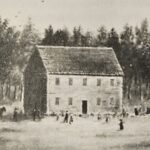
Bloomfield becomes Wintonbury Parish…
<<READ MORE (1600s)
By 1734, there were 27 residents who found the winters too hard to travel the six miles back to the Mother Church in Windsor. They petitioned for “winter privileges,” and when granted, 76 people held church services from November to May on their own. Among the petitioners were: Peter Mills, Daniel Mills, Solomon Clark, Zebulon Hoskins, Abel Gillet, John Hubbard, Moses Cadwell, Nath’l Cook, Alex Hoskins, Anthony Hoskins and Thomas Rowel (Rowley).
By 1736, people from other communities had found the land suitable for farming and families. As a whole, the area was “remarkably excellent” for agriculture, and it yielded large crops of the finest grass, superior apples, pears, cherries, plums and peaches,” to quote Stiles.
Another petition was sent to the Windsor Congregational Church, this time requesting full Parish Privileges. Of those signing the petition, the 52 persons from Windsor were joined by 12 from Simsbury and eight from Farmington. The General Court of Hartford granted the request and a new church parish, called Wintonbury, was originated on February 14, 1738. The next day, a young man from Windsor, the Reverend Hezekiah Bissell, was ordained as minister. He had been prepared for college by the pastor of Windsor, the Reverend Timothy Edwartds, had graduated from Yale in 1733, and was very well respected. He served the church for 45 years, until his death. His house, built in 1750, was located at 669 Bloomfield Avenue.
The Spirit of independence and freedom of religion flourished during these times. In 1740, a new religious society gathered in the part of the area that was governed by the Mother Church in Simsbury. Six men signed a document and presented it to the First Congregational Church of Simsbury, notifying them that these people cherished the Church of England and claimed the liberty granted by law for free worship. They stated they would no longer pay the tax to support the Congregational minister and would build their own house of worship. In this manner, Saint Andrews Episcopal Church was born.
It is written that the Congregational Church was not happy that they would not receive the revenue from the taxes and they attempted to compel the new society to support the “standing order.” In the book, From Wintonbury to Bloomfield, there is a story about one Episcopal clergyman, Reverend William Gibbs was punished for his act by “being transported to Hartford hanging beneath a horse’s belly, his hands and feet roped together.”
After 1750, the Parish of Wintonbury grew in population and many houses were constructed. Some of the property owners seen on old historical maps are names familiar to Latimer Hill Cemetery. To mention a few: Oliver Ellsworth built a house on the corner of Woodland and Wintonbury Avenue, in 1771; Thomas Cadwell built in 1750 at the foot of Latimer Hill; Chauncey Newberry, in 1798, and Joseph Newberry built on Mills Lane in 1776; Isaac Skinner built on Park Avenue in 1770; Reubin Loomis, in 1798, built on Cottage Grove Road; Sam Goodwin, in 1793, built on Simsbury Road and Henry McLean, in 1670, had a home near the Edward Messenger home.
There were four taverns constructed: the Joseph Goodwin Tavern in 1746; the Buttonball Tavern, in 1760; the Adams Tavern in 1750 and the Brown & Griffin Tavern in 1790.
Industry was growing also. In 1760, Joseph Fitch, Jr. established a cooperage on Seneca Road and Daniel Wilcox began manufacturing bear traps. In 1770, William Barton began manufacturing bells and pistols. He cast the first sleigh bells in the United States. A few years later, a carriage and wagon-making business started, and the Brown brothers manufactured drums, including toy drums. There were a saw mill, an oil mill and two sash and blind factories. Captain Filley manufactured tinware which was sold by peddlers in Vermont. There was a grist mill with two sets of stone; one was used for gin distilling. In 1780, the Gillett family was operating a grist mill off Cottage Grove Road, near Bloomfield Avenue.
(to be continued)
from: Not Lost – Gone Before
A History of Latimer Hill Cemetery
by Lucy Woodford Wirsul